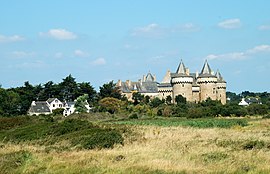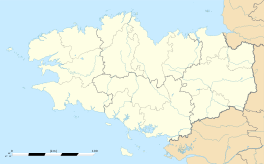Sarzeau
|
Sarzeau Sarzhav |
||
|---|---|---|

Suscinio Castle
|
||
|
||
| Coordinates: 47°31′41″N 2°46′07″W / 47.5281°N 2.7686°WCoordinates: 47°31′41″N 2°46′07″W / 47.5281°N 2.7686°W | ||
| Country | France | |
| Region | Brittany | |
| Department | Morbihan | |
| Arrondissement | Vannes | |
| Canton | Sarzeau | |
| Intercommunality | Presqu'île de Rhuys | |
| Government | ||
| • Mayor (2008—2014) | David Lappartient | |
| Area1 | 60.23 km2 (23.25 sq mi) | |
| Population (2004)2 | 6,941 | |
| • Density | 120/km2 (300/sq mi) | |
| Time zone | CET (UTC+1) | |
| • Summer (DST) | CEST (UTC+2) | |
| INSEE/Postal code | 56240 /56370 | |
| Elevation | 0–42 m (0–138 ft) | |
|
1 French Land Register data, which excludes lakes, ponds, glaciers > 1 km² (0.386 sq mi or 247 acres) and river estuaries. 2Population without double counting: residents of multiple communes (e.g., students and military personnel) only counted once. |
||
1 French Land Register data, which excludes lakes, ponds, glaciers > 1 km² (0.386 sq mi or 247 acres) and river estuaries.
Sarzeau (Breton: Sarzhav) is a commune in the Morbihan department of Brittany in north-western France.
It is located on the Rhuys peninsula between the Gulf of Morbihan and the Atlantic Ocean.
The area around the Morbihan has been occupied since neolithic times. Prehistoric monuments remaining include the menhirs of Kermaillard and Largueven, as well as the dolmens of Kergillet and Brillac. The town itself was first mentioned in the 11th century in reference to an abbey at the site [1]. The nearby Château de Suscinio was built in the 13th century and fortified in the 15th century. The castle was a favorite spot of the Dukes of Brittany who often came for the hunting in the surrounding region [2]. During the Middle Ages, because of its size the town was divided into seven local divisions, a situation that still exists to some extent. The town officially became a commune during the French Revolution. Birthplace of: Alain-René Lesage the Author of Gil Blas.
Inhabitants of Sarzeau are called in French Sarzeautins.
The municipality launched a linguistic plan through Ya d'ar brezhoneg on December the 20th of 2006.
...
Wikipedia



